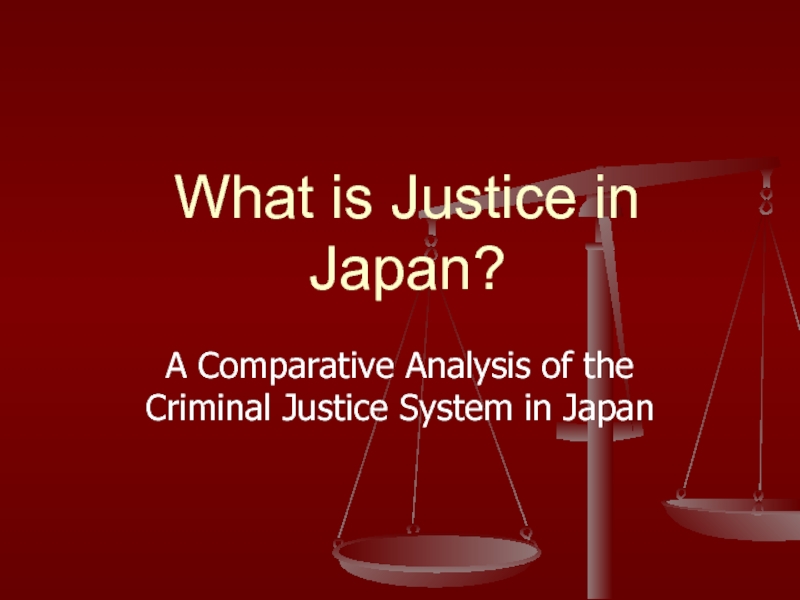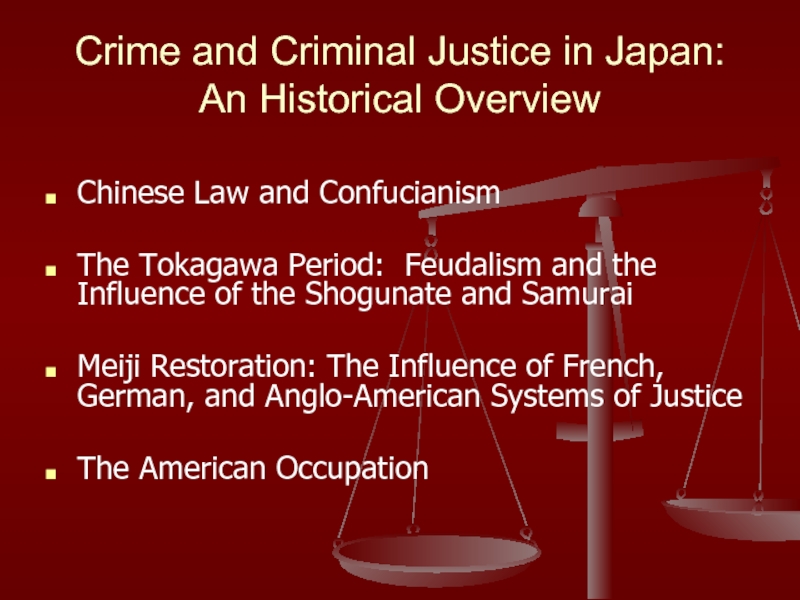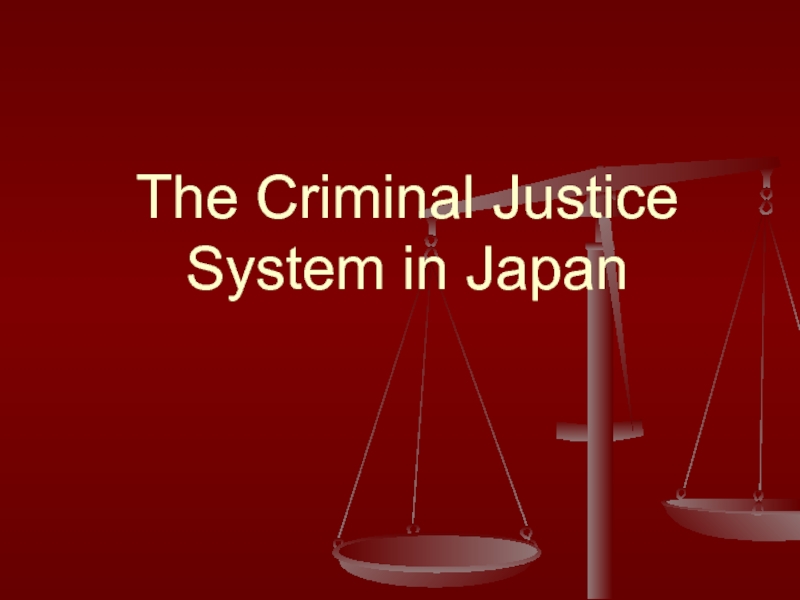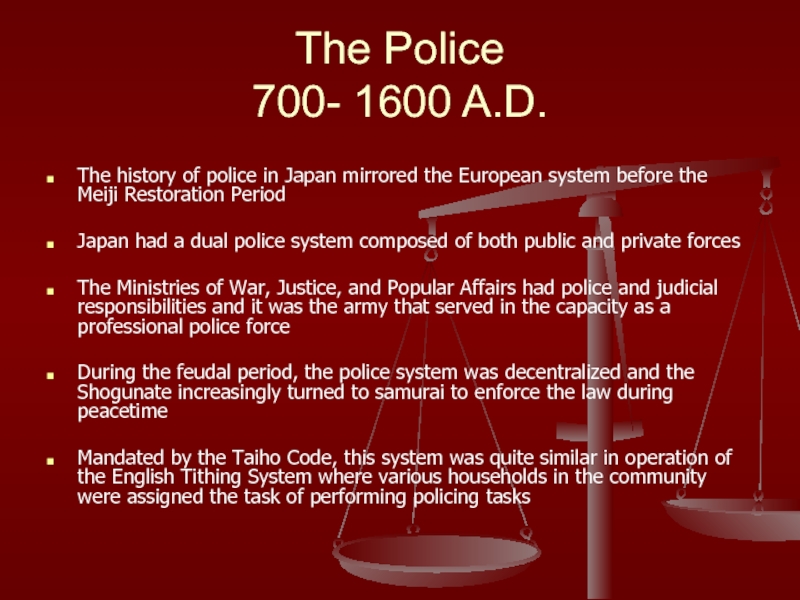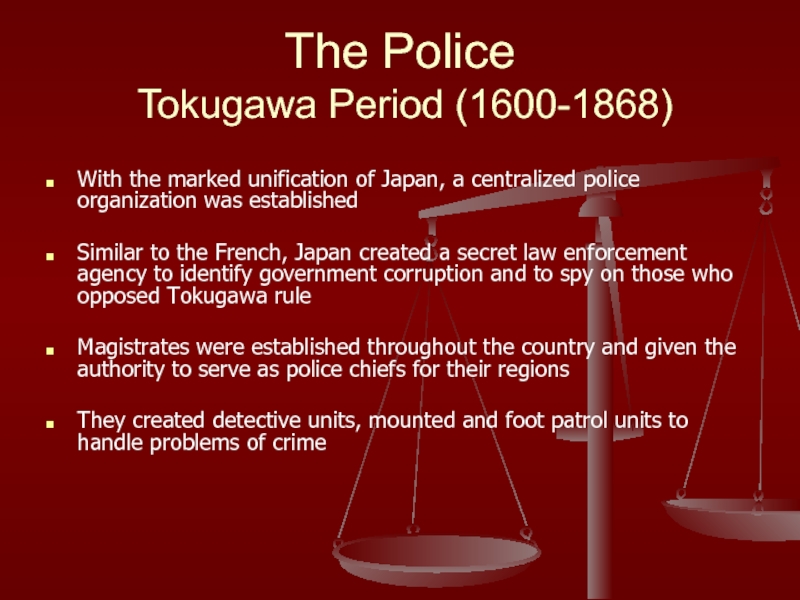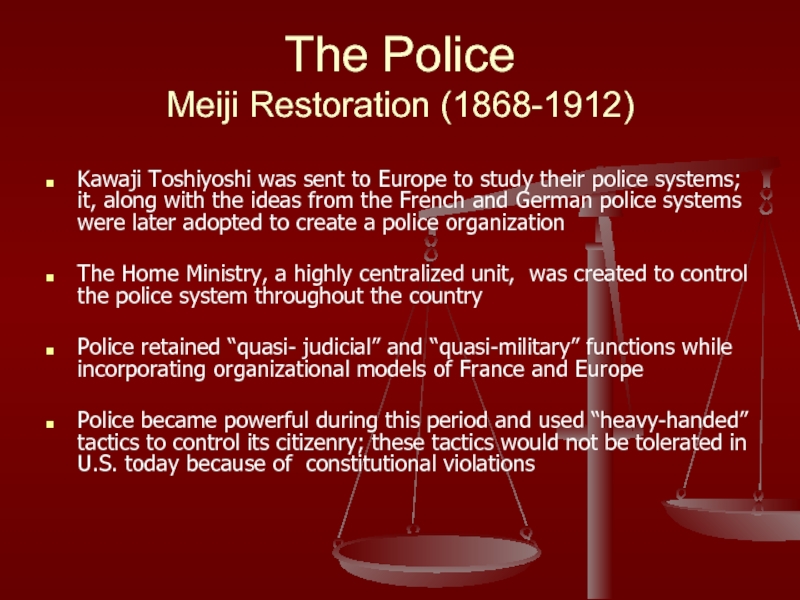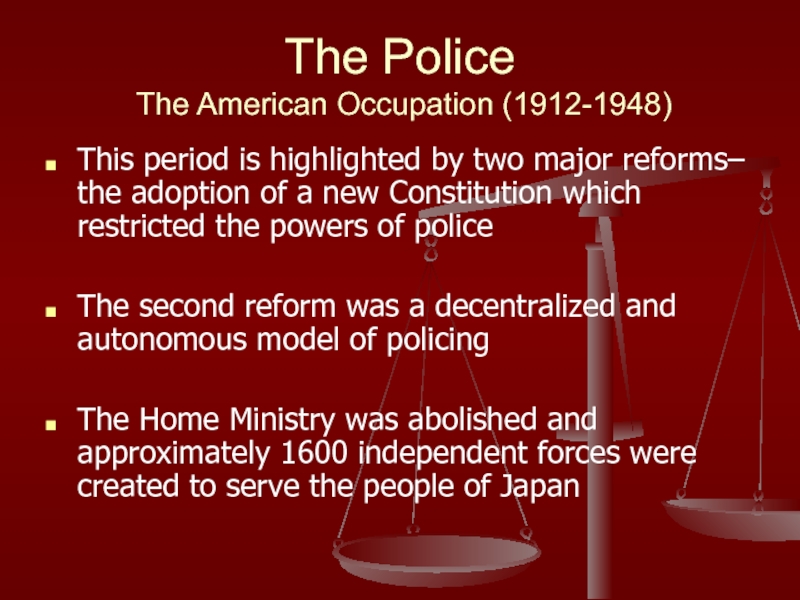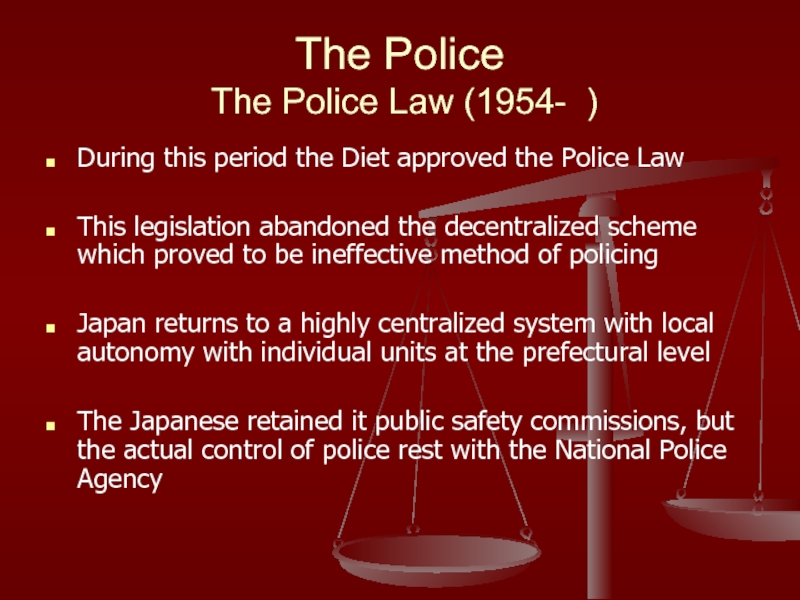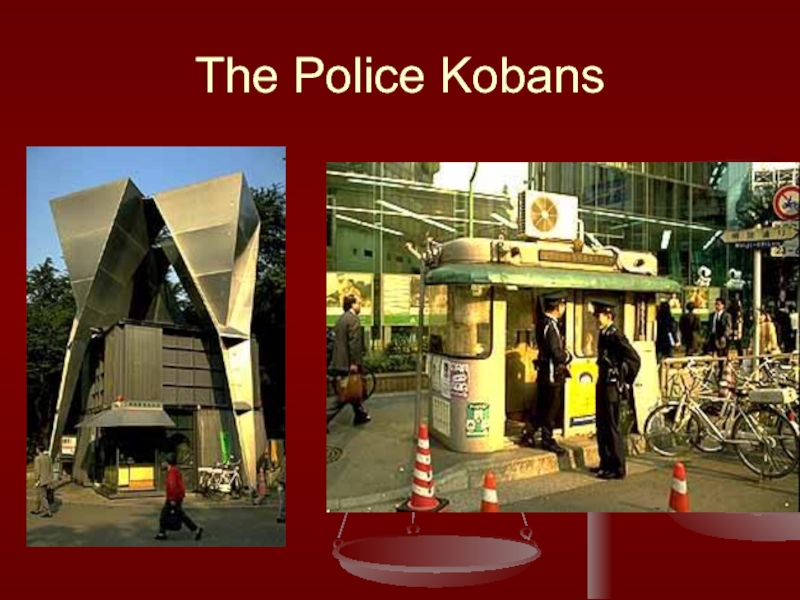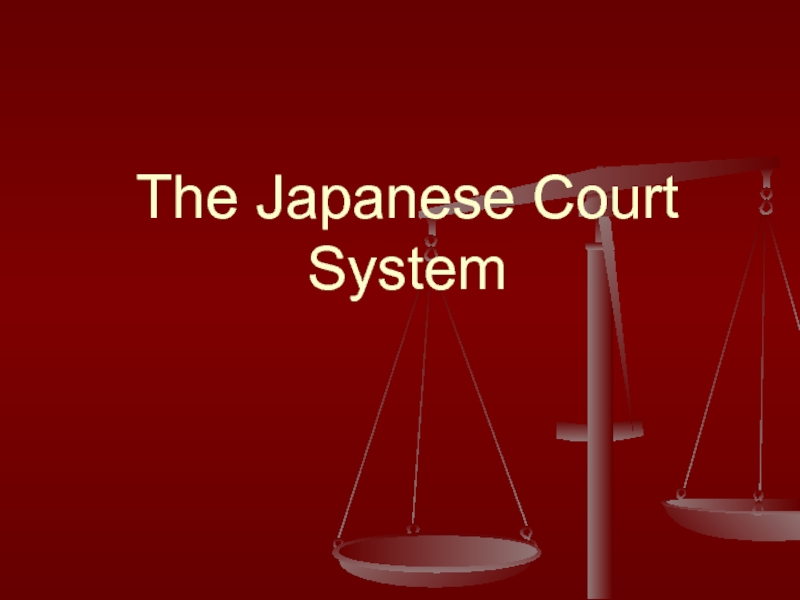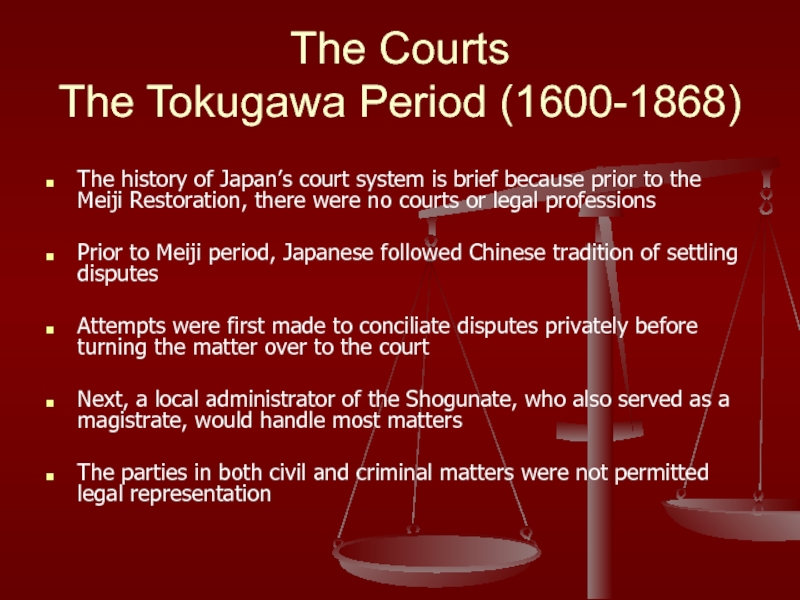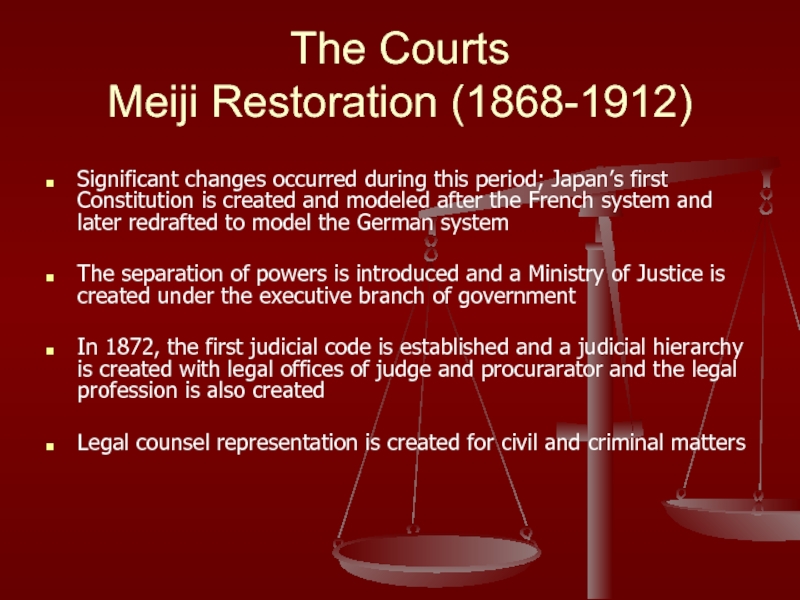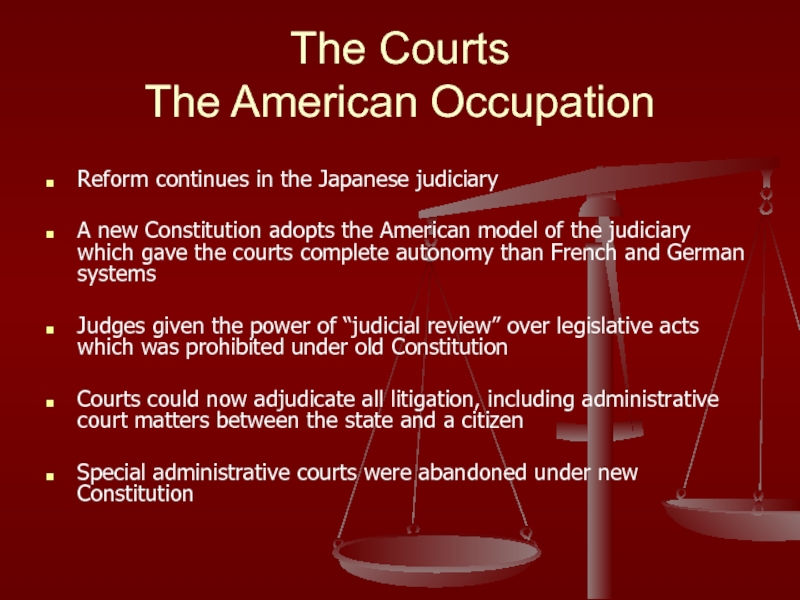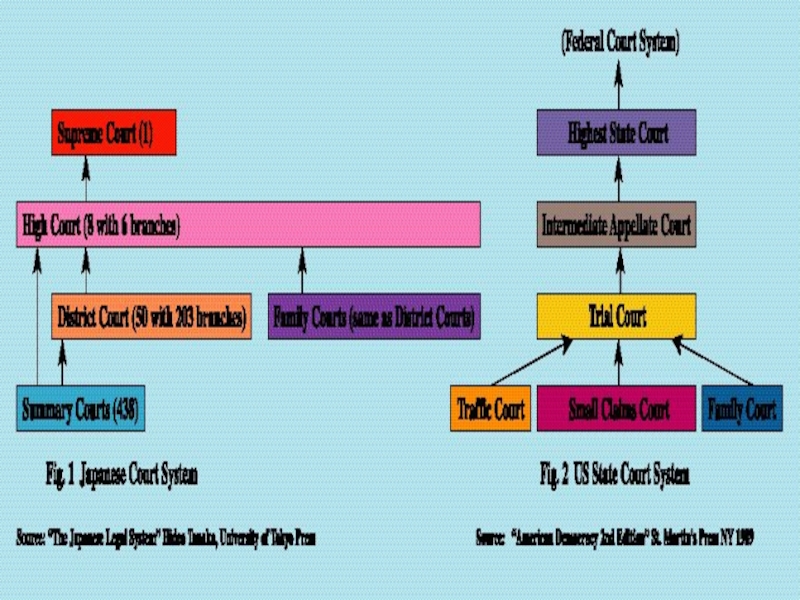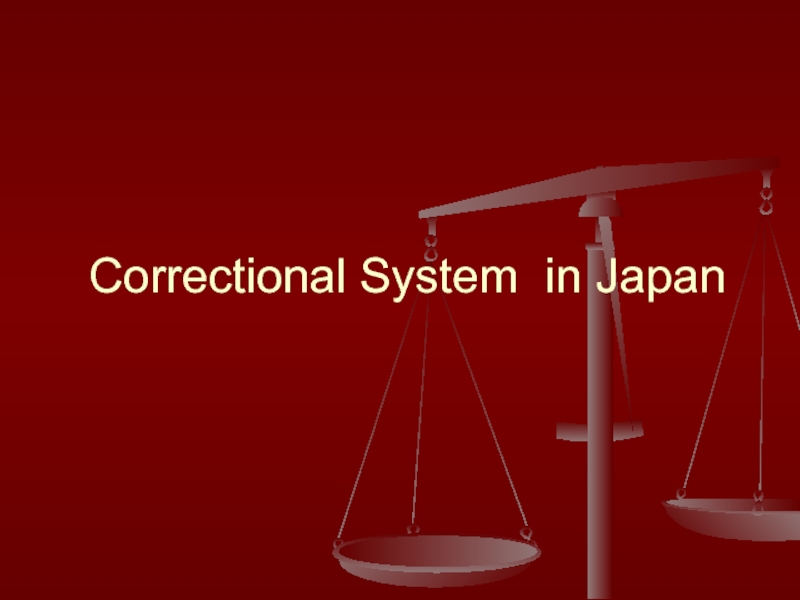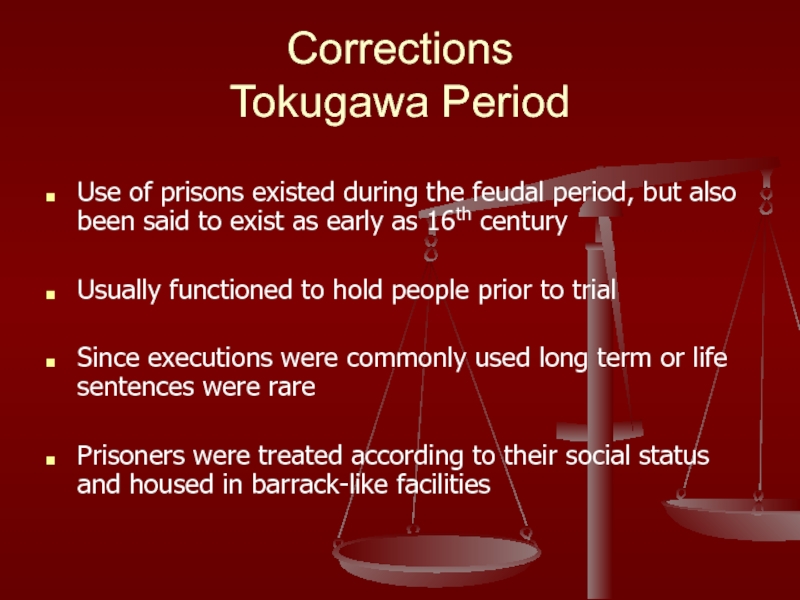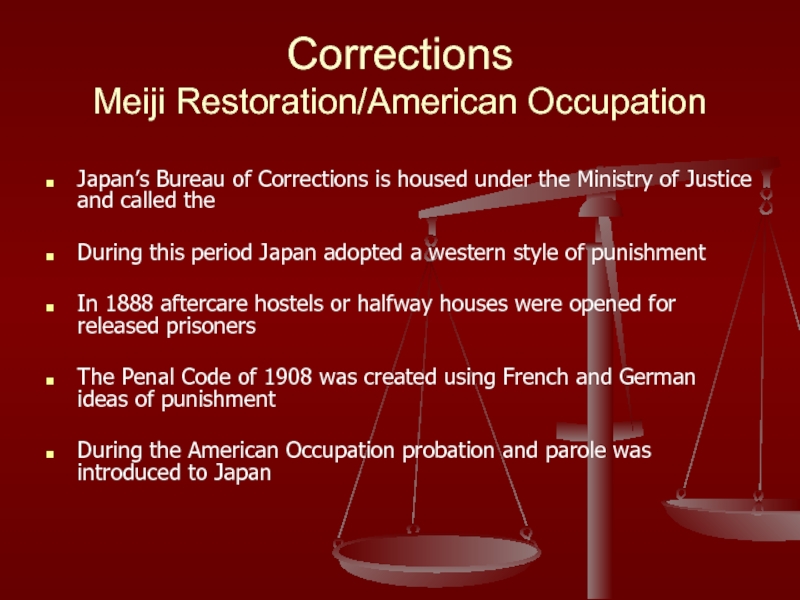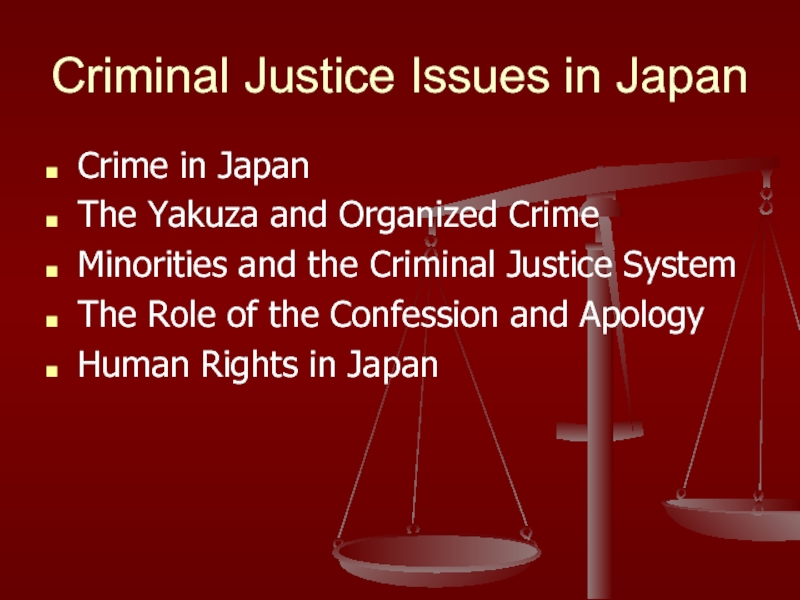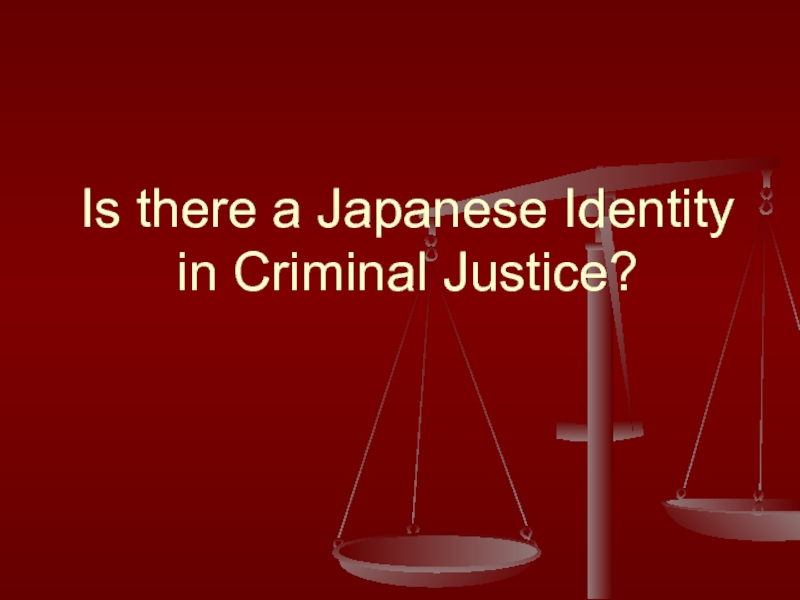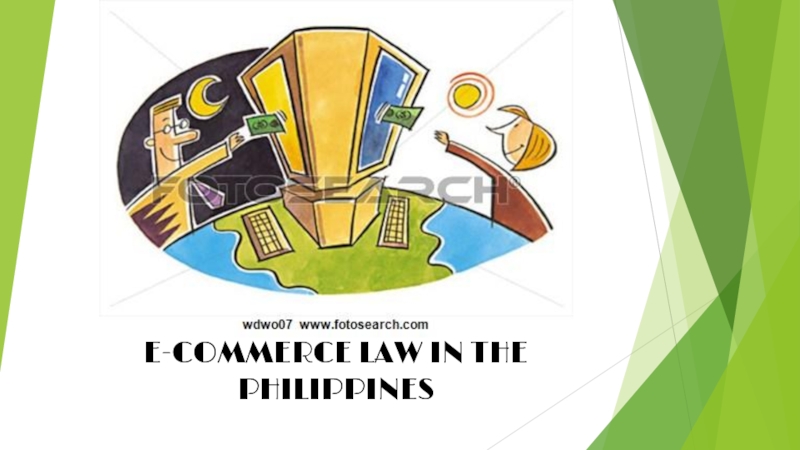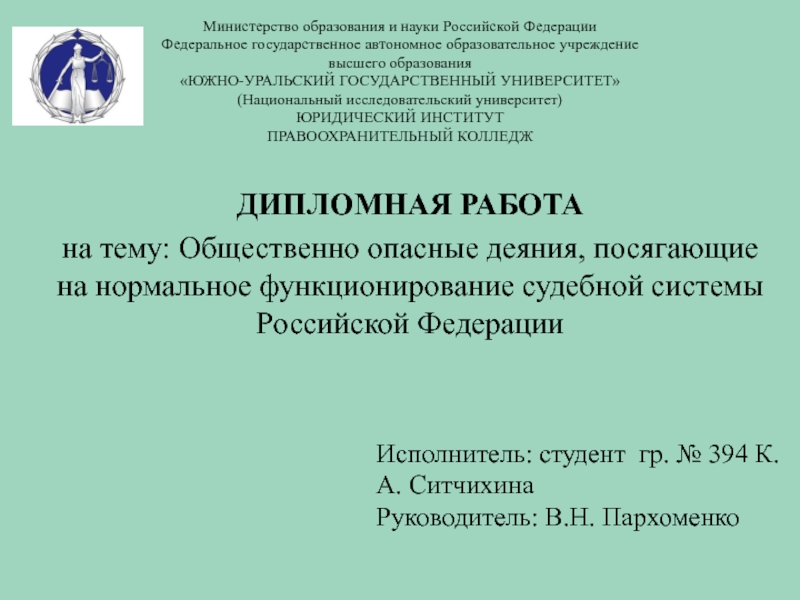System in Japan
- Главная
- Разное
- Дизайн
- Бизнес и предпринимательство
- Аналитика
- Образование
- Развлечения
- Красота и здоровье
- Финансы
- Государство
- Путешествия
- Спорт
- Недвижимость
- Армия
- Графика
- Культурология
- Еда и кулинария
- Лингвистика
- Английский язык
- Астрономия
- Алгебра
- Биология
- География
- Детские презентации
- Информатика
- История
- Литература
- Маркетинг
- Математика
- Медицина
- Менеджмент
- Музыка
- МХК
- Немецкий язык
- ОБЖ
- Обществознание
- Окружающий мир
- Педагогика
- Русский язык
- Технология
- Физика
- Философия
- Химия
- Шаблоны, картинки для презентаций
- Экология
- Экономика
- Юриспруденция
What is Justice in Japan? презентация
Содержание
- 1. What is Justice in Japan?
- 2. Crime and Criminal Justice in Japan: An
- 3. The Criminal Justice System in Japan
- 4. The Police 700- 1600 A.D. The
- 5. The Police Tokugawa Period (1600-1868)
- 6. The Police Meiji Restoration (1868-1912) Kawaji
- 7. The Police The American Occupation (1912-1948)
- 8. The Police The Police Law (1954-
- 9. The Police Kobans
- 10. The Japanese Court System
- 11. The Courts The Tokugawa Period (1600-1868)
- 12. The Courts Meiji Restoration (1868-1912) Significant
- 13. The Courts The American Occupation Reform
- 15. Correctional System in Japan
- 16. Corrections Tokugawa Period Use of prisons
- 17. Corrections Meiji Restoration/American Occupation Japan’s Bureau
- 18. Criminal Justice Issues in Japan Crime in
- 19. Is there a Japanese Identity in Criminal Justice?
Слайд 2Crime and Criminal Justice in Japan: An Historical Overview
Chinese Law and
Confucianism
The Tokagawa Period: Feudalism and the Influence of the Shogunate and Samurai
Meiji Restoration: The Influence of French, German, and Anglo-American Systems of Justice
The American Occupation
The Tokagawa Period: Feudalism and the Influence of the Shogunate and Samurai
Meiji Restoration: The Influence of French, German, and Anglo-American Systems of Justice
The American Occupation
Слайд 4The Police
700- 1600 A.D.
The history of police in Japan mirrored the
European system before the Meiji Restoration Period
Japan had a dual police system composed of both public and private forces
The Ministries of War, Justice, and Popular Affairs had police and judicial responsibilities and it was the army that served in the capacity as a professional police force
During the feudal period, the police system was decentralized and the Shogunate increasingly turned to samurai to enforce the law during peacetime
Mandated by the Taiho Code, this system was quite similar in operation of the English Tithing System where various households in the community were assigned the task of performing policing tasks
Japan had a dual police system composed of both public and private forces
The Ministries of War, Justice, and Popular Affairs had police and judicial responsibilities and it was the army that served in the capacity as a professional police force
During the feudal period, the police system was decentralized and the Shogunate increasingly turned to samurai to enforce the law during peacetime
Mandated by the Taiho Code, this system was quite similar in operation of the English Tithing System where various households in the community were assigned the task of performing policing tasks
Слайд 5The Police
Tokugawa Period (1600-1868)
With the marked unification of Japan, a
centralized police organization was established
Similar to the French, Japan created a secret law enforcement agency to identify government corruption and to spy on those who opposed Tokugawa rule
Magistrates were established throughout the country and given the authority to serve as police chiefs for their regions
They created detective units, mounted and foot patrol units to handle problems of crime
Similar to the French, Japan created a secret law enforcement agency to identify government corruption and to spy on those who opposed Tokugawa rule
Magistrates were established throughout the country and given the authority to serve as police chiefs for their regions
They created detective units, mounted and foot patrol units to handle problems of crime
Слайд 6The Police
Meiji Restoration (1868-1912)
Kawaji Toshiyoshi was sent to Europe to study
their police systems; it, along with the ideas from the French and German police systems were later adopted to create a police organization
The Home Ministry, a highly centralized unit, was created to control the police system throughout the country
Police retained “quasi- judicial” and “quasi-military” functions while incorporating organizational models of France and Europe
Police became powerful during this period and used “heavy-handed” tactics to control its citizenry; these tactics would not be tolerated in U.S. today because of constitutional violations
The Home Ministry, a highly centralized unit, was created to control the police system throughout the country
Police retained “quasi- judicial” and “quasi-military” functions while incorporating organizational models of France and Europe
Police became powerful during this period and used “heavy-handed” tactics to control its citizenry; these tactics would not be tolerated in U.S. today because of constitutional violations
Слайд 7The Police
The American Occupation (1912-1948)
This period is highlighted by two
major reforms– the adoption of a new Constitution which restricted the powers of police
The second reform was a decentralized and autonomous model of policing
The Home Ministry was abolished and approximately 1600 independent forces were created to serve the people of Japan
The second reform was a decentralized and autonomous model of policing
The Home Ministry was abolished and approximately 1600 independent forces were created to serve the people of Japan
Слайд 8The Police
The Police Law (1954- )
During this period the Diet
approved the Police Law
This legislation abandoned the decentralized scheme which proved to be ineffective method of policing
Japan returns to a highly centralized system with local autonomy with individual units at the prefectural level
The Japanese retained it public safety commissions, but the actual control of police rest with the National Police Agency
This legislation abandoned the decentralized scheme which proved to be ineffective method of policing
Japan returns to a highly centralized system with local autonomy with individual units at the prefectural level
The Japanese retained it public safety commissions, but the actual control of police rest with the National Police Agency
Слайд 11The Courts
The Tokugawa Period (1600-1868)
The history of Japan’s court system is
brief because prior to the Meiji Restoration, there were no courts or legal professions
Prior to Meiji period, Japanese followed Chinese tradition of settling disputes
Attempts were first made to conciliate disputes privately before turning the matter over to the court
Next, a local administrator of the Shogunate, who also served as a magistrate, would handle most matters
The parties in both civil and criminal matters were not permitted legal representation
Prior to Meiji period, Japanese followed Chinese tradition of settling disputes
Attempts were first made to conciliate disputes privately before turning the matter over to the court
Next, a local administrator of the Shogunate, who also served as a magistrate, would handle most matters
The parties in both civil and criminal matters were not permitted legal representation
Слайд 12The Courts
Meiji Restoration (1868-1912)
Significant changes occurred during this period; Japan’s first
Constitution is created and modeled after the French system and later redrafted to model the German system
The separation of powers is introduced and a Ministry of Justice is created under the executive branch of government
In 1872, the first judicial code is established and a judicial hierarchy is created with legal offices of judge and procurarator and the legal profession is also created
Legal counsel representation is created for civil and criminal matters
The separation of powers is introduced and a Ministry of Justice is created under the executive branch of government
In 1872, the first judicial code is established and a judicial hierarchy is created with legal offices of judge and procurarator and the legal profession is also created
Legal counsel representation is created for civil and criminal matters
Слайд 13The Courts
The American Occupation
Reform continues in the Japanese judiciary
A new Constitution
adopts the American model of the judiciary which gave the courts complete autonomy than French and German systems
Judges given the power of “judicial review” over legislative acts which was prohibited under old Constitution
Courts could now adjudicate all litigation, including administrative court matters between the state and a citizen
Special administrative courts were abandoned under new Constitution
Judges given the power of “judicial review” over legislative acts which was prohibited under old Constitution
Courts could now adjudicate all litigation, including administrative court matters between the state and a citizen
Special administrative courts were abandoned under new Constitution
Слайд 16Corrections
Tokugawa Period
Use of prisons existed during the feudal period, but also
been said to exist as early as 16th century
Usually functioned to hold people prior to trial
Since executions were commonly used long term or life sentences were rare
Prisoners were treated according to their social status and housed in barrack-like facilities
Usually functioned to hold people prior to trial
Since executions were commonly used long term or life sentences were rare
Prisoners were treated according to their social status and housed in barrack-like facilities
Слайд 17Corrections
Meiji Restoration/American Occupation
Japan’s Bureau of Corrections is housed under the Ministry
of Justice and called the
During this period Japan adopted a western style of punishment
In 1888 aftercare hostels or halfway houses were opened for released prisoners
The Penal Code of 1908 was created using French and German ideas of punishment
During the American Occupation probation and parole was introduced to Japan
During this period Japan adopted a western style of punishment
In 1888 aftercare hostels or halfway houses were opened for released prisoners
The Penal Code of 1908 was created using French and German ideas of punishment
During the American Occupation probation and parole was introduced to Japan
Слайд 18Criminal Justice Issues in Japan
Crime in Japan
The Yakuza and Organized Crime
Minorities
and the Criminal Justice System
The Role of the Confession and Apology
Human Rights in Japan
The Role of the Confession and Apology
Human Rights in Japan
